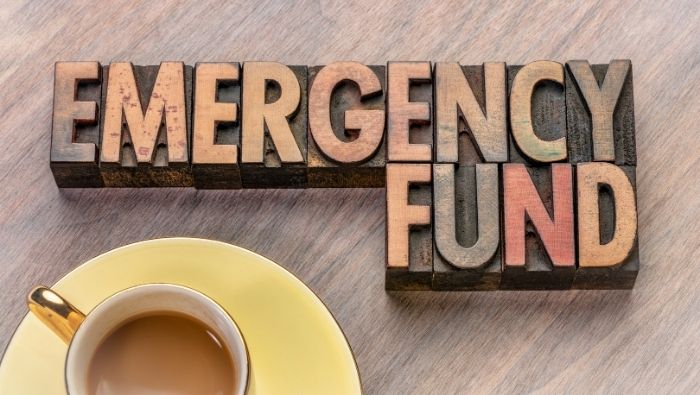Easy Steps To Building an Emergency Fund on a Tight Budget
by Andrea Norris-McKnight

Creating an emergency fund is one of the smartest financial gifts you can give yourself. Take these easy steps and get started saving today.
How do you create an emergency fund when there’s no money left at the end of the month?
Saving money can be challenging, no matter how much money you make. There will always be one more unexpected bill, one more item to buy, or one more payment to make. Yet, creating a cushion, or an emergency fund, is one of the smartest financial gifts you can give yourself.
Read on for the steps to building an emergency fund on a tight budget.
10 Steps To Building an Emergency Fund on a Tight Budget
1. Change your mindset.
You’ll likely need to cut back on some spending to build your emergency fund. That thought alone is one of the reasons many of us do not have an emergency fund.
So don’t equate saving with deprivation or you’ll never reach your savings goals. You won’t have to penny-pinch forever if you can gradually build savings and get control of your finances.
If you’re having trouble with a mindset shift, try this advice for developing a frugal attitude.
2. Pay yourself first.
If you wait until everything else is paid, your money will be gone at the end of the month and you’ll never build your emergency fund.
Designate a percentage of your first paycheck of each month, or a set dollar amount, as emergency fund savings. Try for 10%, but even a little adds up over the long haul.
This payment to yourself is as much a part of your budget as your electric bill. Treat it that way.
3. Use automatic deposit to transfer that monthly savings into a dedicated emergency fund account.
Out of sight means out of mind. Using direct deposit you probably won’t even miss it. But your emergency fund will grow every paycheck. It’s like putting “pay yourself first” on autopilot.
Not sure you can pay yourself first on your tight budget? Find out how to make “pay yourself first” work for you.
And consider keeping your savings in an account dedicated to your emergency fund. Co-mingled funds in one account often get spent on non-emergencies.
4. Get a clear understanding of what constitutes a financial emergency.
One reason some people aren’t successful in building up an emergency fund is that they “borrow” from it every time they are short on cash.
One simple rule for protecting your emergency fund is to never use your emergency funds for “wants.” (See Need To Trim a Tight Budget? Get Honest About Wants Vs. Needs.) And if you’re going to use your funds for a “need,” try only to use it for immediate needs.
For instance, if your only transportation to work is your own vehicle, a car repair would be considered an emergency expense if it means keeping your job. However, if you can catch a ride with a co-worker or ride the city bus to work for a few pay cycles, you might consider putting the car repair on hold for a few paychecks until you have most or all of the cash for the repair.
5. Set up a sinking fund to protect your emergency fund.
Another category of expenses that should not be paid with your emergency fund is known as future expenses.
Let’s say you pay your auto insurance premium in full every six months. When your bill comes due, you should not pull that money from your emergency fund. You know it’s coming, so you should save for it over those six months.
If your premium is $400, stash $67 in a separate account (often referred to as a sinking fund) or even in an envelope, and you’ll have the $400 by the due date and you’ll keep your emergency fund intact.
Sign Up for Savings
Subscribe to get money-saving content by email that can help you stretch your dollars further.
Twice each week, you'll receive articles and tips that can help you free up and keep more of your hard-earned money, even on the tightest of budgets.
We respect your privacy. Unsubscribe at any time.
6. Don’t trade debt repayment for saving.
Trying to balance debt repayment and saving can be tough on a tight budget, especially when it comes to credit card debt.
But while building your emergency fund, you probably still want to pay more than your credit card minimum payments to reduce the time it takes you to get out of debt and the amount of interest you pay. (If you want to crunch the numbers to determine the best use of your extra money, we walk you through the math in Build Emergency Fund or Repay Debt First?)
Chances are, that debt is why your budget is so tight right now. So don’t neglect your debt. No debt means peace of mind and more money to save toward a fun goal, such as a vacation.
And an emergency fund will go a long way in keeping you from getting back into debt.
These tips for finding money for savings while paying down debt can help you balance the two.
Get proactive about tackling your debt.
Get the book How to Conquer Your Debt No Matter How Much You Have and begin the journey to financial freedom today!
7. Have a plan for unexpected extra cash.
Just like you’ll have unexpected expenses, occasionally, you’ll find yourself with unexpected extra cash.
Create some rules around how you’ll use unexpected windfalls. Perhaps half will go into your emergency fund and half will be for fun money. Or if you’re carrying debt, do a three-way split between debt repayment, your emergency fund, and fun money.
8. Set mini-goals and reward yourself when you reach them.
Start by aiming to save $200. When you reach that, make $500 your next goal. Then $1,000.
It is much easier to work toward a goal than the vague notion of “saving more money.”
When you reward yourself, your determination grows to reach the next goal.
9. Once your emergency fund starts growing, recognize its value.
You know that life is full of unexpected financial challenges — car repairs, home repairs, unplanned medical bills. You know your emergency fund will be there for you when needed.
Don’t overuse it or treat it carelessly.
10. Enjoy compounding interest while building your emergency fund.
You might not need your emergency funds right now, but it doesn’t mean that money can’t work hard for you earning compound interest until you do. Your fund will grow that much faster.
How To Save for an Emergency Find When Money Is Tight
Maybe your budget is so tight that you couldn’t squeeze an extra nickel out of it no matter how hard you tried. So, where will you find extra cash for an emergency fund?
Below are some opportunities that could work for you. Also consider these tips from other Dollar Stretchers: Finding Money for Emergency Savings.
Cut food costs.
Perhaps you’ve cut your grocery budget to the bone. But have you really? We offer a very affordable ebook filled with 300+ tips that can help you cut the food budget even further.
Use a cashback credit card.
Are you sure that you’re using the right credit card? If you’re not getting cash back, you’re giving away free money that could go to your emergency fund.
Most of us use our credit cards almost every day. Buying everything from snacks to 70″ TVs. Why not get a free discount when you do?
The best way to find the best cashback card for you is to compare offers. You could be creating a monthly source of income and never do another thing to earn it!
Get a credit card with a lower interest rate.
Sometimes you can’t help it. You have to pay the credit card minimum. If so, you could save money by reducing your interest rate, especially if your credit score is above 650.
Create a second income stream.
Maybe you really want to give that emergency fund a boost! A little here and there isn’t enough for you. Then, you might want to start a side gig. Here are some side gigs to consider that can earn you extra cash.
Creating an Emergency Fund Is Possible on a Tight Budget
We all know that emergencies do happen, and being prepared for them can make all the difference between weathering the storm and being overwhelmed. If you don’t have an emergency fund yet, today is the day to begin building one. As the fund grows, your peace of mind will, also.
Reviewed February 2024
About the Author
Andrea Norris-McKnight took over as the editor of The Dollar Stretcher and After 50 Finances after working under the site founder and previous editor for almost 15 years. She has also written for Money.com, GOBankingRates.com, HavenLife.com and The Sacramento Bee.
Sign Up for Savings
Subscribe to get money-saving content by email that can help you stretch your dollars further.
Twice each week, you'll receive articles and tips that can help you free up and keep more of your hard-earned money, even on the tightest of budgets.
We respect your privacy. Unsubscribe at any time.
Popular Articles
- 7 Habits of Highly Frugal People
- 5 Simple Budget Cuts That Can Save $200 a Month
- How to Track Down Unclaimed Funds Owed You
- 32 Ways to Save Money on Your Utility Bills
- Do You Need Credit Life Insurance When Buying a New Car?
- How to Maximize Profits When Selling Online
- Staying Motivated to Continue Digging Yourself Out of Debt
On After50Finances.com
- 9 Things You Need to Do Before You Retire
- You Didn’t Save Enough for Retirement and You’re 55+
- When Empty Nesters Reorganize and Declutter Their Home
- Reinventing Your Career in Your 50s or 60s
- What Mature Homeowners Should Know about Reverse Mortgages
- 2 Reasons to Collect Social Security Benefits As Soon As Possible

